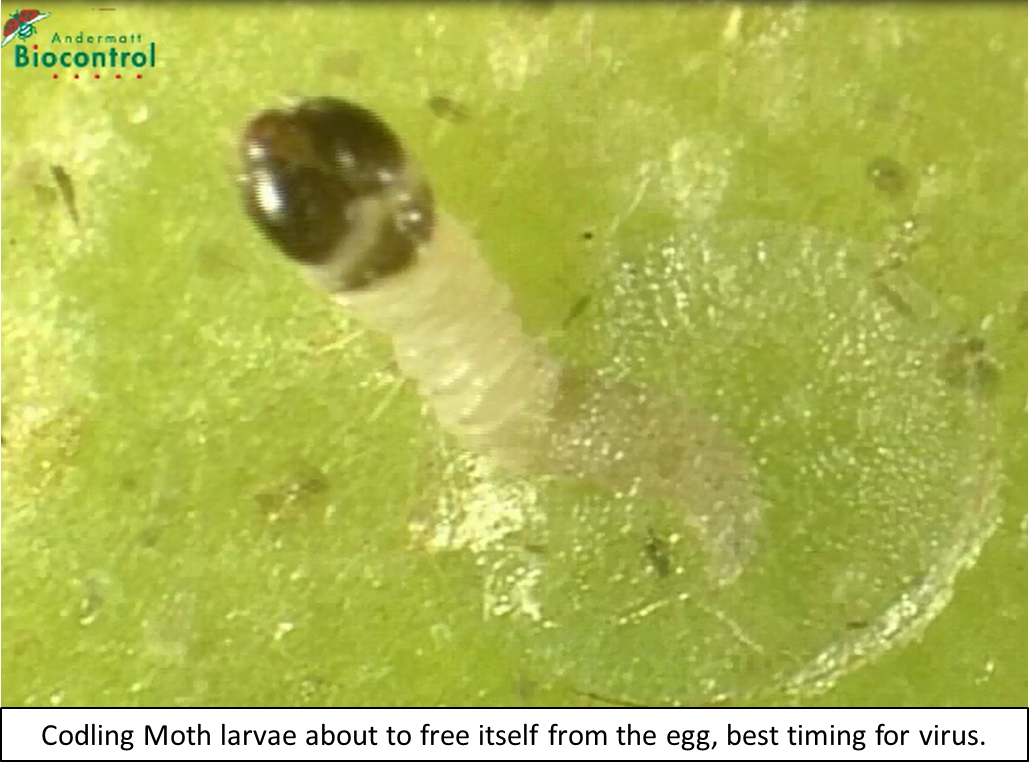GRANDEX is from the same stable as MADEX®, developed by the world leader in insect virus technology; Swiss Company, Andermatt Biocontrol. GRANDEX was developed in response to reduced sensitivity of CM in Europe to MADEX. Andermatt were able to screen for and isolate a more virulent strain of the Cydia Pomonella (Codling Moth) Granulosis Virus which successfully dealt with the resistance problem and opened up the efficacy window to include OFM. The active substance of Grandex is a Cydia pomonella granulovirus (CpGV) that was selected on an Oriental Fruit Moth population. These viruses belong to the family of insect pathogen baculoviruses that occur naturally in lepidopteran (caterpillar) species.
Like all biological products GRANDEX requires the user to closely monitor for moth flights so as to predict the timing of egg laying using degree days, this egg laying stage is the best timing. This is done in an attempt to infect the larvae with GRANDEX when they first feed. GRANDEX has very good rain fastness and is pH stable up to pH 8.5 making it a utility biological tank mix with other conventional chemistry. Dose rates are low at only 100ml/ha when used as a standalone application or at lower rates when tank mixed with conventional chemistry. The product comes in two convenient pack sizes of 200ml and 1L to meet both ends of the market.
Grandex is available as a suspension concentrate containing > 3 × 10¹³ occlusion bodies of Cydia pomonella granulovirus per litre. The industry standard application is 100 mils per hectare with standard re application required during the life cycle every 8 days of full sunshine. As the product acts via digestion it is imperative to target the hatching of the larvae and best population reduction is achieved through targeting the first generation. Water volume per hectare should be adjusted according to leaf area index and spraying equipment. Due to the formulation of Grandex and the fact that it contains no chemical ingredients and leaves no residue on the crop there are no restrictions or withholding periods and re-entry periods. Another benefit for IPM and Organic growers is that there is no impact on non-target organisms and the formulation complies with Australian Organic standards.
There are different use strategies available and Grandex can fit into most conventional spray programs. Due to the broad pH range that the product can tolerate and the stability of the formulation Grandex is compatible with most insecticides, fungicides and fertilizers. A pH level between 5 and 8.5 in the tank mix has to be respected otherwise the protective protein capsule will be destroyed and the active substance inactivated. Avoid tank mixes with copper products. Spraying of copper a few days before or after a Grandex application has no adverse effect. The product formulation guarantees excellent rain fastness within 3 to 4 hours after spraying with no need to add stabilisers or wetters/stickers. The other significant practical aspect of the product formulation is its storage stability of > 2 years at –18 °C, 2 years at 5 °C and 3 months at 20 °C.
Granuloviruses are encapsulated within a protein occlusion body, which protects the virus from destructive environmental influences (e. g. UV radiation). The size of a single virus particle is not bigger than 400 nm. Young larvae that are actively moving and feeding on twigs, leaves or fruits will eventually ingest the virus that was sprayed onto the plant surface. Following ingestion, the virus particles enter the larval midgut, where the protein capsules dissolve due to the high pH level (pH higher than 10). Within 2 – 4 days, the viruses infest most organs of the host and the larva stops feeding. Upon death, the larval body liquefies and releases millions of new viruses into the environment, infecting other larvae. Laboratory tests revealed that as little as 1 – 2 ingested virus particles are sufficient to cause 50% population mortality.

Older larvae (older than L3) are not instantly killed and therefore can cause damage before getting killed in later larval instars (which is often reflected by superficial or deeper stopped damage in the fruit). The virus infection can also be transferred to the next generation, where it can outbreak due to weakness or stress and kill the larva (also during hibernation) thus providing excellent population control.
The larvae have to ingest the viruses to get infected. Young larval instars are killed faster than older instars. For best crop protection, the first Grandex spray is therefore applied right before first egg-hatch, and before the larvae enter the fruit. Use local forecast system (based on phenology models) if available. On sites with very high pest densities, it is recommended to combine fast acting larvicides at the peak of larval hatching, in order to keep superficial and stopped damage low. Grandex reduces the overall population on a long term.
As viruses are sensitive to UV radiation and especially stone fruit trees have a strong vegetative growth, sprays must be repeated at an interval of 8 days of full sunshine to assure a constant coverage (2 partly sunny days are equal to one sunny day) during the larval hatching period.
Application in the late afternoon or early evening hours is recommended.
Due to the unique mode of action of the virus, infected larvae can still cause superficial damage on the fruit before getting killed by the virus. Therefore, it is important to distinguish between superficial damage, stopped damage and full damage to the core. Stopped damage signifies the activity of the Granulovirus and the successful control of the larvae post digestion of the virus.
The monitoring of hibernating oriental fruit moth and codling moth is important, because Grandex has a strong effect on the pest population. The virus is underestimated by only assessing the total damage on the fruit. In contrast, larvae that survived a chemical treatment will have no barrier, complete their development and reproduce without further population control. A larvae infected with a low virus concentration will eventually die sooner or later during its development cycle and thus break the lifecycle.
As a seasonal spraying strategy the best timing for this product is for the first predicted generation of the season, as any superficial damage to the fruitlets will either abort or be thinned off at a later date. Growers who do not want to suffer damage or are not confident can tank mix with a conventional insecticide to reduce the potential amount of damage.
For further information about this product and how it can fit in your crop protection strategy contact Scott Brady at Organic Crop Protectants on 0488 717 515 or

